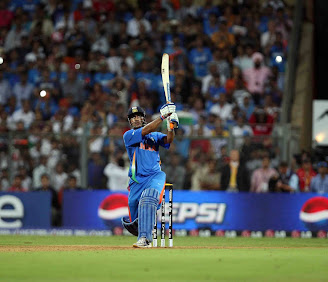A
batsman who many modern observers rate second to Bradman is Viv Richards. Sir
Vivian was indeed king, monarch of all he surveyed in the sheer dominance of
his strokeplay. He was mesmerised by Chandrasekhar on debut at
I was fortunate to see that knock of his at the Ferozshah Kotla. At that time we knew nothing about the awesome strokeplay that he was capable of, but his power was certainly in evidence. One shot that has remained in my memory was the one he played while batting at the pavilion end. He hit one of the spinners straight and high, up above the big advertisement hoarding perched atop the stands, landing probably in the centre of the adjoining Ambedkar Football Stadium. I have never seen a cricket ball sailing that high ever again. Brijesh Patel, fielding at extra-cover, rolled his fingers around his eyes as though spotting the little spheroid with a pair of binoculars. It was a hit nobody ever forgets.
The other thing that I noticed was his dead-bat defence. Time and again during that long innings he would drop deliveries from the spinners Venkataraghavan, Prasanna and Bedi right under his eyes. He would then either bend down and pick up the ball, or tap it with his bat, passing it to the forward short-leg fielder Solkar. Whenever I hear people talk about Richards’ tremendous strokeplay, and how they felt he was vulnerable early in his innings because he whipped balls from outside his off-stump to the on-side, I always think back to that impregnable defence. Of course he was a blaster, but he was also a master for, like all the great players, he had a very good defence. People, particularly English ‘experts’, mocked at Bradman as well early in his career. Look what he did to them.
It
was indeed a delight to see Richards bring up his first Test century and go on
the rampage towards the latter stages, returning unconquered with 192. It was
the beginning of the Richards saga. He was soon to become the best
When
the just-appointed
A
decade later in 1985-86, Richards blasted the fastest recorded hundred in terms
of balls. He brought up his century in 56 deliveries before delighted home fans
at
Richards
was the first batsman to dominate in Tests as well as One-day Internationals.
If his electrifying fielding turned the World Cup final versus Australia in
1975, four years later his tremendous 139-run fifth-wicket stand with Collis
King turned the second World Cup final. Richards scored 138 to raise a
match-winning total. In 1984, also against
He
took over the captaincy of the West Indies after Clive Lloyd retired in 1985
and under him the
When
he called it a day, Richards had surpassed Sobers’ highest Test aggregate for
the
Statistics,
though, scarcely tell the tale of one of the most self-assured cricketers ever.
Helmets came into the game early in Richards’ career but he shunned them even
when confronted with the fastest of bowlers. He would walk out to the crease
proudly wearing his maroon
His haughty stance itself would put the jitters in the hearts of all but the most strong-hearted of bowlers. And then he would stun them by firing a bullet from outside the off-stump, screaming to the mid-wicket boundary before the startled fielders could even react. Yes, it was like a shot from a gun, not a stroke off a bat.
Richards made stroke-making look so natural, as if it were the easiest thing in the world. He would spot the ball early and then either take a big stride forward or rock back, or even step away to leg and whack the ball away. His stunning drives and pulls would leave the bowlers looking on in despair. Richards made a virtue of backing away to leg and hitting inside-out through the line. The desperation of the bowlers and fielding captains can then be imagined. To a ball pitched on or outside the off-stump, Richards could cream it across the line to the on-side; and to the delivery on or outside the leg-stump, he might loft it through the line on the off-side. If he chose to, he would just as well slam it in orthodox fashion. That is why captains were confused as to the field to employ, and the bowlers confounded regarding the line to bowl. That is also the reason why he scored so rapidly.
They said he was vulnerable early because he was not copybook. That is only an illusion thrown up by mere theorists. Which batsman is not vulnerable early in his innings? If he were that vulnerable, he would have been sorted out early in his career by the world’s best bowlers. Instead he sorted out the greatest bowlers through his long career. Vivian Richards was an original, just as Bradman was. That is why armchair critics picked holes in their techniques as if there were a law as to how one should bat. They would do well to remember that Bradman and Richards were a law unto themselves. Just look at the scorecards, and the outstanding results their teams achieved.
(Author Indra Vikram Singh can be contacted on email singh_iv@hotmail.com).
Don’s Century
Published in India by Sporting Links
ISBN 978-81-901668-5-0
Fully illustrated
Paperback French Fold 11 x 8.5 x 0.4 inches
Weight 480 grams
188 pages
Available
on Amazon at an attractive price:
https://www.amazon.in/dp/8190166859
Indra
Vikram Singh's other books available on Amazon:























